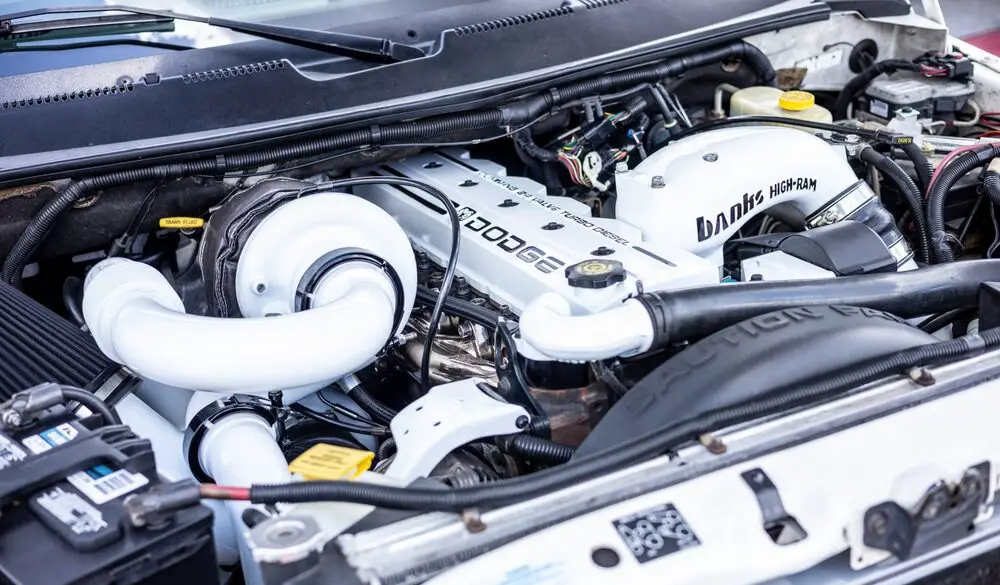
Dodge is generally a hardy vehicle brand, and the Cummins engine even more so. Still, like any engine, you can run into problems, and one of the more common ones is the P003A code.
Having this pop up on your vehicle can be daunting, but how serious is it, and how can you fix it?
The P003A code indicates an issue with the turbocharger or supercharger, which the powertrain control module has detected. More specifically, it usually means the charger’s actuator is failing and needs to be cleaned or replaced.
In this article, I’ll walk you through replacing a faulty actuator to get rid of the P003A error code and, more importantly, fix the root problem. Let’s get your baby back to smooth sailing in no time!
1. Reach the Turbocharger Behind the Wheel
The first thing to do is gain access to the turbocharger.
- First, drain the coolant. The turbocharger is connected to coolant wires, making it quite challenging to work with if left undrained.
- Then, take out the wheel. Once it’s out, you need to take out the bug and rock shield that can be found along the wheel. You will see the actuator immediately. It is attached to the round-shaped turbocharger via four screws which you will have to unscrew. You will also see a wire attached to the actuator.
- To detach, simply press the head of the wire down to loosen its connection and pull the head away.
2. Detach the Actuator
In Dodge Cummins vehicles, the actuator is situated sideways, making it difficult to reach, so be warned. After gaining access to the turbocharger, detach the actuator by doing the following:
- On the lower left of the wire’s head is another screw you must remove. This can be done by hand.
- Then, use your grip to pull up the entire actuator. If you’ve unscrewed it successfully, it should come off quickly. Where the actuator used to be are two big holes and a triangular-shaped gear with teeth-like edges on the base.
- Using a piece of cloth or a gentle scouring pad, clean the area of any oil, rust, or debris. The turbocharger may not have been properly positioned because foreign materials entered the actuator. This could have been the main culprit.
3. Position the Positioning Arm Accurately
The triangular gear is called the positioning arm, which you must position properly. Try moving it around from left to right. If it moves easily, no oil or debris is getting in the way.
The arm has a hole that falls directly in line with another hole beneath it. This hole leads the air into the manifold. Position the arm such that you can fully see the hole. This is the calibrating position.
4. Clean and Reattach the Actuator
Now is the time to reattach the actuator. Simply follow these steps:
- Lay the top of the actuator flat onto a table and clean it thoroughly.
- Remove the old gaskets (if you haven’t touched your actuator before, they should be colored black) and replace them with new ones.
- Re-attach your actuator to the wire and connect it to the computer scanner. Your car needs to be turned on for this step. What you will be doing is installing and aligning the actuator onto the engine.
5. Replace The Actuator
Alternatively, if your actuator is damaged it may not work even after cleaning. While oil and debris can be easily cleaned, problems like corrosion are far more serious and require a more expensive solution.
Typically, you’ll need to order a new actuator. Taking it to the mechanic will run you quite a bit of money and although you can do it yourself, a new actuator on it’s own is also pretty expensive. Regardless, you’re going to need to crack open your wallet.
If you choose to go the DIY route, here’s how you can replace your actuator properly:
- Follow the steps above to remove your old actuator.
- Your replacement actuator should come with rubber seals that you can simply snap on the grooves.
- Ensure that the actuator is clean, dry, and free from oil before attaching it.
- Attach it to the turbocharger. Once the replacement actuator is comfortably seated, screw in the actuator.
- Turn the screws until they’re tightly fitted. After that, reconnect the actuator to the wires.
Note that there are aftermarket options for actuators. While regular actuator replacements can be in the range of $700-$900, aftermarket alternatives are around $500. However, do study these replacements well, as they may do more damage to your car.
6. Installing and Calibrating Using Snap-on
Calibration requires the following actions:
- If you’re using a Snap-On car diagnostic tool, go to the “Select System” menu. From there, click “Engine.” That should take you to the Engine’s Main Menu; click “System Tests.” Click “VGT Turbo Actuator Pre-Align/Self Calibrate.”
- Click “Continue” when you see the message box. Follow the instructions on the Snap-on. You will have to place the actuator onto the turbocharger at some point.
- Re-screw the screws onto the holes. Once you’re done, you will use your Snap-on again to calibrate the actuator onto the engine.
- Click “Continue.” You will hear some sounds coming from the turbocharger. This is the controlling arm trying to find the proper position from the commands it gets on the Snap-on.
- Once you have completed the process, click “Exit.”
Take your vehicle out for a drive. If the code does not show up anymore, you should be good to go.
7. Installing and Calibrating Using Insite
The calibration and installation process is quite different on the Insite diagnostic tool.
- On the sidebar, click on “ECM Diagnostic Tests.” This should show the ECM Diagnostic Tests Wizard. Then, go to “VGT Electronic Actuator Installation And Calibration.”
- Under the “Inputs” tab, click on the drop-down box under “Value.” Click on “Install Actuator.” The message box will warn you not to place the actuator on the turbocharger. Set the actuator aside for the time being.
- Click “Start” and allow it to run. This may take a couple of minutes. You should be able to see the actuator’s gears turning if you have resolved all the actuator issues. If it doesn’t turn, that means the actuator is bad. You will get notified by Cummins Insite if it fails.
- Once it’s done, attach the actuator to the turbocharger. Go back to your computer and click “Calibrate Actuator” on the same drop-down box you clicked on earlier.
Take your vehicle out for a drive. If the code does not show up anymore, you should be good to go.
What Causes the P003A Code on Dodge Cummins?

A P003A error typically means there’s a problem with the actuator in your turbocharger or supercharger. For most dodge cars, you’re likely dealing with a turbocharger.
Within your turbocharger are a series of vanes that control how much gas enters the turbine wheel, which is controlled by the actuator. Modern cars are quite “smart,” and the turbocharger is built to manage the amount of air it lets in precisely.
To achieve such precise results, the powertrain control module (PCM) commands the actuator to shift the vanes’ positions depending on the required intake. If the PCM senses that the actuator is positioned more than 15% from the commanded position, it sends the P003A error.
The very first things you may notice prior to getting the code is a bad fuel economy and random stuttering in your vehicle. This is because the turbocharger cannot properly function and control how much power goes into the boosts.
It’s important that you work on this code immediately because the amount of unregulated motion within the turbocharger may ultimately harm other components in your Cummins.
If you really have to use your vehicle now, it’s generally fine if it runs even with the code, but you must get it fixed as soon as possible.
In really bad cases, be prepared for the mechanic to replace the turbocharger or supercharger as a whole. Usually, this will cost much more than an actuator replacement.
Professional Replacement vs Self-Replacement
It goes without saying that the replacement process is quite tedious. But it is very possible. Actuators online can set you back roughly $999 for the Dodge Cummins. Meanwhile, getting it replaced by a professional can set you back a staggering $3500.
How you choose to go about it should depend on your ability to devote hours to the task and your budget. This is also a complex operation overall, so pulling the wrong wires and unscrewing vital parts may do a lot more damage to your vehicle.
Conclusion
The P003A code is almost always due to an error in the turbocharger or the supercharger. For the Cummins, it’s typically due to an actuator error.
Luckily, as long as you got the right equipment, a handy diagnostic tool, and some patience, you should be able to fix it in no time.
Still, I’d only recommend doing this yourself if you’re handy with cars. If you aren’t, it’s a much better option to take it to a professional.
Other common error codes on the dodge cummins and how to fix them:
